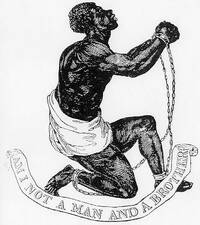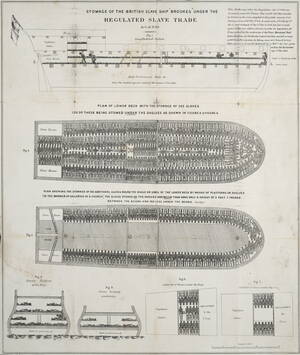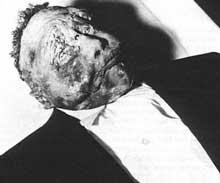PBS120Y: Why Victim Photography?
Recommended Co-requisite: PBS121Y
Presentation
Slides are available here: http://media.trtl.ca/abortion/victim-imagery.html
- press the space bar to advance to the next step
- press “s” if you want to see the presenter's view, along with all the notes
CCBR believes that imagery is a powerful tool that must be incorporated into its educational efforts. A major component of our EndTheKilling plan is the saturation of Canadian culture with images of the victims of abortion. There are three primary reasons that we use abortion victim photography in all our projects:
- History: Our strategy has worked for social reform movements in the past
- Resistance: The abortion movement has said our strategy works and is a threat
- Results: We have the fruits of our work to prove our success.
History
- CCBR's work is grounded in lessons learned from successful social reform movements. It simply models the concepts from these organizations in its fight against abortion. Groups that have been historically effective in changing society's perspective and behaviour towards an injustice typically had three characteristics in common:
- They exposed an injustice using shocking images and evidence.
- They confronted the culture.
- They were willing to endure persecution.
Many movements have resorted to images, especially graphic images, to convey a message to the culture. Certainly that is not the only thing which occurred, but it was often central. Images have long been a useful and essential tool to teach things which words alone cannot convey. In particular, injustice that is not seen is rarely understood. One such movement that has successfully demonstrated a keen understanding of this principle is the abolitionist movement in Britain.
Abolitionists
- The slave trade was deeply ingrained into the British economy for centuries, but was out of sight for the British public; empty ships would leave England, go pick up slaves in Africa, leave the slaves in the Americas, and come back laden with goods. Most British people had never even seen a person with dark skin.
To the British abolitionists, the challenge of ending slavery in a world that considered it fully normal was as daunting as it seems today when we consider challenging the entrenched wrongs of our own age: the vast gap between rich and poor nations, the relentless spread of nuclear weapons, the multiple assaults on the earth, air, and water that must support future generations, the habit of war. None of these problems will be solved overnight, or perhaps even in the fifty years it took to end British slavery. - Adam Hochschild, Bury the Chains 1)
- In an age before photography, social reformers in Great Britain knew that in order to end the slave trade, they would have to expose the slave trade. Abolitionists like William Wilberforce and Thomas Clarkson forced slavery into the public consciousness so that the British had to confront it. As one of the first grassroots human rights campaigns, they used evidence of the barbarism of slavery. They shared first-hand testimonies from people who conveyed the deplorable conditions of the slave ships. They showed chains and other equipment used to abuse Africans. And images of slavery were key to their educational efforts.
Am I not a Man and a Brother?
Public ignorance and indifference began to change thanks to work of abolitionist Josiah Wedgewood. Wedgwood mass-produced medallions depicting the seal for the Society for Effecting the Abolition of the Slave Trade and had them widely distributed. The medallion made a simple plea for the humanity and rights of slaves: “Am I not a Man and a Brother?”
It quickly saturated society and became the most famous image of a black person in all of 18th-century art. Clarkson wrote, “Ladies wore them in bracelets, and others had them fitted up in an ornamental manner as pins for their hair. At length the taste for wearing them became general, and thus fashion, which usually confines itself to worthless things, was seen for once in the honorable office of promoting the cause of justice, humanity and freedom”.
But simply showing the humanity of slaves wasn’t enough—some people argued that their lives as slaves were actually better than their lives in Africa, and would be even worse if they were freed. The abolitionists also had to show the inhumane nature of slavery.
The Slave Ship Brookes
In 1788, they began using one of their most powerful tools yet: a drawing of the inside of the slave ship “Brookes.”
“[The diagram] gave measurements in feet and inches while showing the slaves closely lined up in rows, lying flat, bodies touching one another or the ship’s hull… The diagram began appearing in newspapers, magazines, books, and pamphlets; realizing what a powerful new weapon it had, the [abolitionist] committee also promptly printed up more than seven thousand copies as posters, which were hung on the walls of homes and pubs throughout the country.” 2)
- This picture looks tame by today's standards, but it was considered so graphic in the 18th century that abolitionists avoided showing the image to elderly supporters, for fear that it would cause them a heart attack. Historian Eric Metaxas said that for the people of the day, to look upon this picture was like looking into Hell.
sources??
In the face of hundreds of years of slavery, after the abolitionists started exposing the reality of slavery, it took only 20 years to abolish the slave trade in the British empire. Within their lifetimes, Wilberforce and Clarkson saw the abolition of the slave trade in 1807, and the abolition of slavery itself in the empire in the 1830s. Nations around the world soon followed suit.
stuff about Wilberforce introducing legislation–then changing strategies. Need sources on this*
What can we learn from the tactics of the abolitionists? Why was advocating for anti-slavery legislation not sufficient to successfully pass the legislation?
Anti-Child Labour Movement
Child labour increased in the US during the Industrial Revolution. As society moved from primarily agrarian to industrial, children were a cheap source of labour for factories, mines, and other places. They were being forced to do hard labour often from 6am to midnight, working on starvation wages, losing any chance of childhood and education; many also lost limbs, and sometimes lives, while they worked.
“Child labor in this country was so widespread, and so much a part of economic reality in the early part of the 19th century, that no one looked toward or expected its abolition” - Report on the Youth Labor Force, Bureau of Labor Statistics [2000] 3)
The National Child Labour Committee worked to stop the exploitation of children through labour. They recognized that public policy around child labour would not change until public opinion changed. In fact, one of their leaders, the outspoken activist Florence Kelley, wrote the following concerning legislation around child labour: “Our first task is to give wide publicity to the disease-breeding conditions of the tenements, thus leading the legislature to make a fresh attempt at outright prohibition…Until that is done, all attempts at regulation of manufacture are illusory; they simply lull the public conscience vainly and cruelly, when it ought to be alert and militant.” 4)
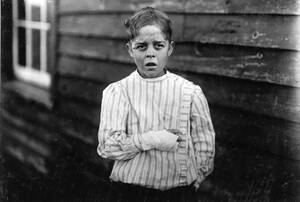 In 1908, an American photographer, Lewis Hine, was hired by the U.S. National Child Labour Committee to photograph images of children working long hours, often in dangerous conditions, being robbed of their childhood.
In 1908, an American photographer, Lewis Hine, was hired by the U.S. National Child Labour Committee to photograph images of children working long hours, often in dangerous conditions, being robbed of their childhood.
- “To gain access to factories, mines, sweatshops, and mills, and to use his camera freely, Hine often had to disguise his real purpose…he [posed] as a fire inspector, or an insurance salesman, or an industrial photographer who was after pictures of buildings and factory machinery” -Russell Freedman, Author of Kids At Work: Lewis Hine and the Crusade Against Child Labor [1994]
- Hine's poignant pictures showed the public the reality of what labour in factories, mines, and fields did to young children.
- Hine and the NCLC worked to saturate the country with images of the injustice. The NCLC distributed pamphlets and flyers containing the images, alongside arguments against child labour; newspapers and magazines published them; and large displays were set up in public places, such as at fairs and expositions.
- “These photos traveled the nation on exhibit panels, poster-sized display boards that the reformers brought to their own conferences, to city streets, and to expositions… In these panels, Hine's images are clipped out of their backgrounds, arranged into charts, shaped into diagrams, circled and underlined and surrounded by slogans and calls to action” -Library of Congress [1954]
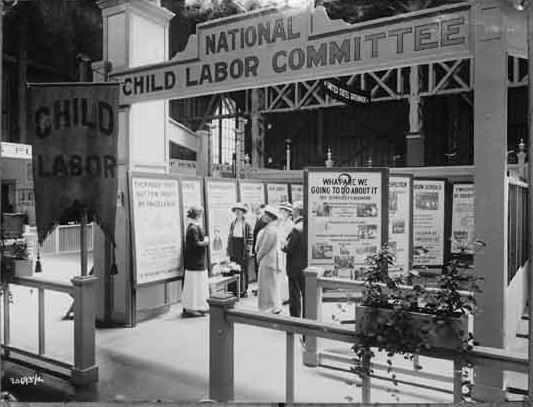 National Child Labor Committee's exhibit for the Panama-Pacific International Exposition of 1915 in which they use various displays composed of Hine's photos [Library of Congress NCLC Collection, 1915]
National Child Labor Committee's exhibit for the Panama-Pacific International Exposition of 1915 in which they use various displays composed of Hine's photos [Library of Congress NCLC Collection, 1915]
- His life was threatened several times because of what he was doing(
source?), and when people complained, he said:
“Perhaps you are weary of child labor pictures. Well, so are the rest of us, but we propose to make you and the whole country so sick and tired of the whole business that when the time for action comes, child labor pictures will be records of the past.”
12 years after he started taking these photos the number of child labourers was roughly cut in half 5). Continued campaigns against child labour, aided by Hine's photographs, resulted in many states passing stricter laws around child labour 6). By 1941, the Fair Labour Standards Act was passed to prohibit the vast majority of child labour7). Those are the same laws, in America, that protect children today.
Why do you think that Hine and the NCLC did not simply show images of happy, healthy children to convince their culture of the immorality of child labour? Why was it necessary to show unpleasant, often graphic images of actual child labourers?
Civil Rights Movement
https://www.endthekilling.ca/training/classroom/reform/civilrights

Civil rights activists courageously exposed the injustice of racial segregation and made sure that Americans could see its brutality. Whether it was the shocking pictures of Emmett Till or the disturbing images of peaceful civil rights activists being attacked by racist bullies, they strived to effect change.
Emmett Till
- In 1955, Emmett Till, a 14-year-old African-American from Chicago, was visiting family in Money, Mississippi. While there, he went to a corner store and allegedly said, “Bye, Baby,”8) and whistled at the white woman behind the counter.9) A few days later, relatives of that woman kidnapped Emmett from his uncle's home. They brutally beat him, shot him in the head, and disposed of his body in the Tallahatchie River. They were never convicted of their crime, but later confessed their guilt.10)
When Emmett’s body was recovered, it was sent to a funeral home in Chicago. Upon seeing Emmett’s mutilated body, his mother declared that she wanted an open casket at the funeral, saying, “Let the people see what I’ve seen.”11)
Dr. Clenora Hudson-Weems, Ph.D., wrote a book about this incident entitled, Emmett Till: The Sacrificial Lamb of the Civil Rights Movement. In it, she argues that Till’s beating and death was the catalyst for the Civil Rights Movement. Hudson-Weems interviewed civil rights activists who testified that Till’s murder motivated them to fight for the equality of African-Americans.12)
In the month following Till’s murder, five out of six black radio preachers aired sermons about what had happened to the young boy. There was also nationwide television coverage of the trial of the suspected murderers.13)

What is interesting is that today most people credit Rosa Parks, the African-American woman who refused to surrender her bus seat to a white man, as being the catalyst for the Civil Rights Movement. Hudson-Weems’ research shows otherwise and she provides a compelling quote from Emmett’s second-cousin to provide insight into this situation:
Historians will talk about the good and the bad, but they don’t want to deal with the ugly… The ugliness of racism is not a White man’s telling a Black woman to give him her bus seat—bad as that is—but the confident home-invasion, kidnapping and murder of a fourteen-year old Black youth and the exoneration by jury of the youth’s apparent killers.14)
In 2005, Rosa Parks died. At her funeral, Reverend Jesse Jackson said that he had asked Parks why she didn’t give her bus seat to the white man in 1955 and quoted Parks as having said, “I thought about Emmett Till, and I couldn’t go back.”15)
Exposing Segregation's Brutality
Opening the casket on injustice was a controversial step, but an important one for the Civil Rights Movement. They knew it required leaving the comfort of their churches and confronting the culture at whites-only lunch counters, on segregated buses, and in other public areas. When they did this, they were persecuted brutally:
“Look back to the civil-rights-era images: Fire hoses. Lunging dogs. Citizens hammered for the audacity of attempting to vote, to ride a bus or sit at a lunch counter.
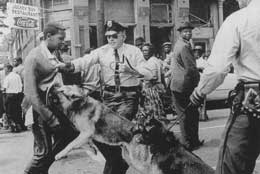
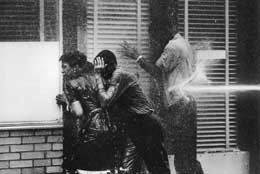 ‘People talked about justice for years and years, but suddenly you could see a graphic illustration of injustice,’ says Jim McNay, who teaches visual journalism at Brooks Institute of Photography in Santa Barbara, Calif.
‘People talked about justice for years and years, but suddenly you could see a graphic illustration of injustice,’ says Jim McNay, who teaches visual journalism at Brooks Institute of Photography in Santa Barbara, Calif.
When 900 students marched for freedom in Birmingham, Ala., on May 3, 1963, police attacked with dogs and fire hoses. Dramatic photos… dominated the news. Demonstrations erupted in 186 cities. President John F. Kennedy called for the Civil Rights Act. The nation faced up to injustice ‘because the pictures backed up the words,’ one senator said.”16)
These direct-action campaigns were bold and were even criticized by prominent people who opposed segregation. In defending these tactics, Dr. Martin Luther King, Jr. wrote the following in his //Letter from a Birmingham Jail//:
Like a boil that can never be cured so long as it is covered up but must be opened with all its ugliness to the natural medicines of air and light, injustice must be exposed, with all the tension its exposure creates, to the light of human conscience and the air of national opinion before it can be cured.17)
History, both pre- and post- the era of the Civil Rights Movement, shows that the exposition of images was a powerful tool to convict people. All of these injustices continued because they remained invisible, so social reformers worked to make the injustices impossible to ignore.
Resistance
- One of the most common ways for social movements to judge the success of their tactics is to examine how their opponents react to them. If abortion advocates are not disturbed by our means of activism, then we are clearly doing something wrong: if we are actually exposing the destruction of thousands of children a year, a standard they fight to uphold, then their antipathy towards our tactics is, in a way, one way to measure our success. As pro-life leader Gregg Cunningham notes, effective reformers are rarely liked and liked reformers are rarely effective.
Frances Kissling and Kate Michelman
- Two abortion advocates, Frances Kissling (former president of Catholics for a Free Choice) and Kate Michelman (former president of NARAL Pro-Choice America), revealed that the exposure of the abortion procedure in the public square has created an unparalleled problem for those who defend the procedure. In a Los Angeles Times editorial published in 2008 entitled “Abortion’s battle of messages”, Kissling and Michelman detailed the challenges that they believe abortion advocates face in the ongoing debate:
“In recent years, the antiabortion movement successfully put the nitty-gritty details of abortion procedures on public display, increasing the belief that abortion is serious business and that some societal involvement is appropriate.”18)
- In 2012, Kissling fearfully highlighted the pro-life movement's focus on the pre-born child: “The fetus is more visible than ever before, and the abortion-rights movement needs to accept its existence and its value. It may not have a right to life, and its value may not be equal to that of the pregnant woman, but ending the life of a fetus is not a morally insignificant event.”19)
In other words, these abortion advocates admit that graphic visuals have drastically contributed to a shift in public opinion on abortion.
Naomi Wolf
 Prominent pro-abortion feminist Naomi Wolf also addressed the use of graphic visuals in her article “Our Bodies, Our Souls”, a piece published in the New Republic calling for a change in how abortion advocates make their case. She states: “While images of violent fetal death work magnificently for pro-lifers as a political polemic, the pictures are not polemical in themselves: they are biological facts. We know this.”
Prominent pro-abortion feminist Naomi Wolf also addressed the use of graphic visuals in her article “Our Bodies, Our Souls”, a piece published in the New Republic calling for a change in how abortion advocates make their case. She states: “While images of violent fetal death work magnificently for pro-lifers as a political polemic, the pictures are not polemical in themselves: they are biological facts. We know this.”
In a shockingly honest statement that many in the pro-life movement should take notice of, she adds later that “How can we charge that it is vile and repulsive for pro-lifers to brandish vile and repulsive images if the images are real? To insist that the truth is in poor taste is the very height of hypocrisy.”20)
Joyce Arthur and ARCC
- Joyce Arthur is the executive director of the Abortion Rights Coalition of Canada, an abortion advocacy group. A quick scroll through ARCC's publications will show that responses to CCBR's projects dominate their website21).
- In the spring of 2017, Arthur and other pro-abortion activists lobbied for the federal government to deny Canada Summer Jobs funding to students working for pro-life groups. They named CCBR as one of the principle organizations they opposed:
“Of particular concern to ARCC is the funding of the Canadian Centre for Bio-Ethical Reform (CCBR), an extremist political organization that is best known for its offensive campaigns against abortion using graphic images of aborted fetuses” 22)
* In the summer of 2017, as CCBR's activism continued unhindered (despite the loss of funding for our interns), Arthur released an ARCC publication entitled “Take action against aborted fetus images in public!” Arthur layed out ARCC's efforts to shut CCBR's activities down. The hysteria with which ARCC treats the exposure of the procedure speaks volumes to the effectiveness of this tactic.
Some pro-lifers argue that the use of these images harms the pro-life movement. If that were true, then why wouldn't pro-abortion groups like ARCC simply sit back and let us damage our own cause? Why do they try to cover up the images?
Results

Hearts and Minds Changed
When we engage in our projects, we consistently see people change their minds on abortion–right in front of us. We have countless testimonies from our staff, interns, and volunteers, and you can view more of these stories in our newsletters, on our blog, and on our social media accounts.
Some people do not change their minds immediately, but because the pictures leave a lasting impression, they eventually come to the conclusion that abortion should be unthinkable. Julie shares about how seeing a CCBR display influenced and changed her life.
Statistically-Proven Effectiveness

”[T]he Canadian Centre for Bio-Ethical Reform (CCBR) commissioned several sets of a scientific survey to gauge public opinion on abortion before and after their extensive campaigns in 2015. CCBR delivered postcards with these images to thousands, and commissioned an independent party to survey 1,741 respondents, a sample size sufficient to gauge public opinion within a five-point margin, with 99% certainty that results are generalizable to the entire population of Canada, which is 35,749,600.“ (Study)
Saved Lives
- Baby Ava?
- Baby Noah? (More than 1…)
- Other stories? So many to choose from…
- Statistical effectiveness
“Almost three years ago, I participated in the Genocide Awareness Project. It is designed to expose the inhumanity of abortion through dialogue and displays of images of abortion victims.
On one of our last days of GAP at Florida International University, I met a young woman named Juri. She shared that, two years previous, she and a friend came by the display, literally kicking and screaming. Juri’s eyes fell as she told me how she and her friend talked about how much they hated the team of pro-life students.
A few months later, Juri’s friend became pregnant. She was in a bad place, in a relationship with an abusive boyfriend. But her story – and her baby’s story – do not end there.
Little Roman is now probably in preschool and preparing to enter kindergarten. His mom, Juri’s friend, chose to give him life. Roman returned the favour, as the young woman found the courage to leave the abusive relationship after he was born. He is the light of their lives.
Juri couldn’t remember why, but for some reason she kept the pro-life pamphlet she angrily snatched at the display. Taking another look changed her life, seeing what abortion would have done to little Roman.
I share this story because the message Juri shared with me is not just for me to hear.
She said: 'I have no idea who those pro-life people were, those people we yelled at years ago. It hurts to think I’ll never be able to thank them in person. Can you tell them? Tell them: thank you for saving my nephew. Thank you for saving my Roman. Maybe, somehow, those pro-life people we yelled at will hear this message and be encouraged to keep up the good work they are doing.'”
The stories, stats,and saved lives make it crystal clear: we must continue our efforts to show the truth. For once Canadians see what is chosen, they increasingly reject the abortion “choice.” The abortion advocates want the cover-up to continue. The pro-life movement must not aid the abortion industry in this death-sustaining cover-up.
https://www.youtube.com/watch?v=0_Zy1jSGJpo https://www.youtube.com/watch?v=oUIQlfx1zGA
Other Links
- A Picture Is Worth A Thousand Words: Images That Changed The World - 7-min pro-life video on history of images in social reform
- Responses to common questions: http://www.cbc.ca/news/canada/hamilton/news/replay-graphic-anti-abortion-imagery-effective-or-not-1.1873093
- Verbal descriptions
add video from SLL conference of all the Choice Chain testimonies–would be great to show in the “fruits of our work” section
https://youtu.be/KZH5RKvMbJo cognitive dissonance – baby when wanted, fetus when unwanted
